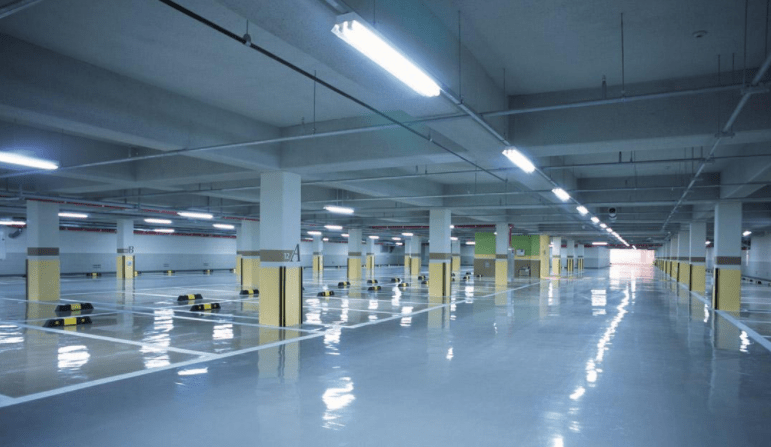LED bulbs have taken the place of traditional bulbs in almost all applications. Whether you consider the residential, commercial, or industrial sectors, you can always see that the traditional bulbs have now lost their presence and are replaced by LEDs. There are various reasons that have led to such replacement; the major one is savings.
LED bulbs have minimized the use of energy by 90 percent as compared to traditional bulbs, and it helps save on utility bills. On the other hand, the lifespan of these bulbs is 25 times longer than that of traditional bulbs, which means less replacement and maintenance is needed.
If you look forward to understanding and getting detailed insight into the actual money-saving LED lights offered compared to traditional ones, the guide below will provide all the answers. So, let’s read below:
Understanding the Technology: LED Vs CFL Vs Incandescent Bulbs
The light bulbs are of various kinds, each with a different type of technology. Understanding this technology is also significant in knowing about their savings.
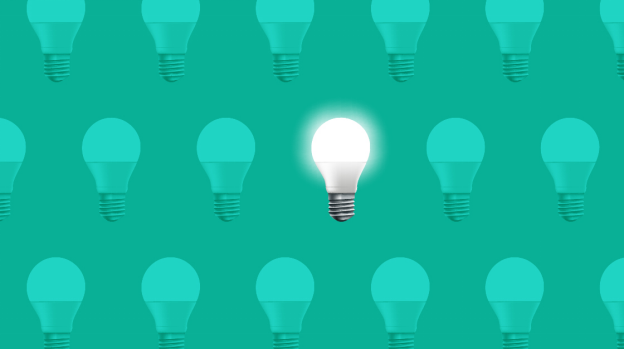
LED Technology
LED bulbs use semiconductors, which help produce light and work by moving electrons within the semiconductor. As soon as
electric current passes through LEDs, the electrons move and release energy in the form of light, also known as photons. The light released will have various colors, depending on the semiconductor material’s energy band gap.
The LED technology has multiple features, and these comprise the following:
- LED bulbs are equipped with high energy efficiency and use a very small amount of electricity to convert it into light.
- LED lights’ lifespan is very high, which helps save on costs as they last for thousands of hours.
- LEDs offer instant lighting and need no warmup time.
- There are multiple color options available in the LED lighting.
- They are highly durable and consist of solid-state lights.
CFL Technology
CFLs are known as Compact Fluorescent Lamps, which are way too different in technology compared to incandescent bulbs. Compared to incandescent lights, the CFLs are more energy efficient, durable and have less environmental impact.
The working mechanisms of the CFL technology are as follows:
- CFL bulbs have a minimal amount of mercury vapor and a phosphor coating inside the glass tube, and when the electric current passes through this gas, UV light is produced.
- The UV light then reacts with the coating of phosphorus present inside the tube, which emits visible light
- CFL bulbs consist of ballast, which helps control the current flow through the bulb and regulates the flow of current when the light is operating.
Incandescent Bulb
The incandescent bulbs are the traditional bulbs of older technology, which LED and CFL now overtake. The incandescent bulbs are less energy-efficient and need more durability than CFL and LED bulbs.
The working mechanism of the incandescent bulb comprises the following steps:
- The incandescent bulbs have a tungsten filament within them, and the bulb is made of glass. The electric current, upon passing through the filament, heats it.
- Upon heating, the filament emits a light followed by infrared radiation.
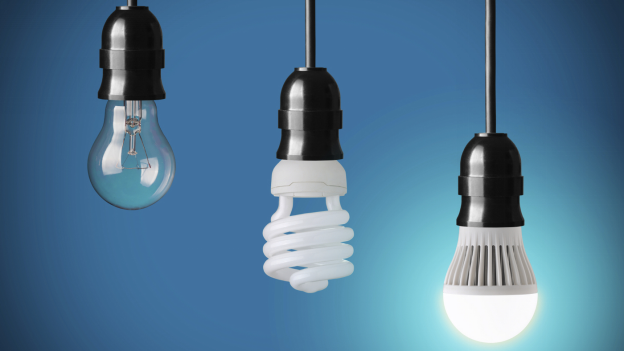
Calculating Energy Savings
In order to make the right decision about the cost-saving and energy efficiency of a light bulb, it is imperative to understand the energy consumption of each type of bulb. The breakdown of the electricity consumption of every kind of bulb is discussed below:
- The typical wattage of LED bulbs is between 6 and 12 watts, and they are extremely energy efficient compared to incandescent bulbs, offering the same brightness level. They have high lumens per watt when compared to traditional bulbs.
- CFL bulbs have a wattage between 9 and 15 watts and are more energy efficient when compared to incandescent bulbs. However, the wattage of CFL bulbs is higher than that of LED bulbs.
- Incandescent bulbs have a 40 to 100 watts wattage, and they consume more energy due to their higher wattage.
LED Electricity consumption
LED electricity consumption can be taken as an example by considering a 16-watt bulb, which will emit the light emitted by a 100-watt incandescent bulb. This bulb, however, uses only 140 kWh of energy throughout the year, and its cost of electricity consumption is around $20, which is quite affordable. Moreover, the durability of LED bulbs is highly commendable, and they will last for the entire year, unlike incandescent bulbs.
CFL Electricity consumption
In the same way, if we take the example of a 25-watt CFL bulb, it matches the brightness level of a 100-watt incandescent bulb by consuming about 216 kWh every year. The electricity cost of this consumption is around $32, and replacing a CFL bulb is done once every six months.
Incandescent Bulb Electricity consumption
Now, if you use an incandescent bulb of 100 watts throughout the year, its energy consumption will be 876 kWh, and the cost of electricity will be above $130 throughout the year. Moreover, it needs at least a monthly replacement.
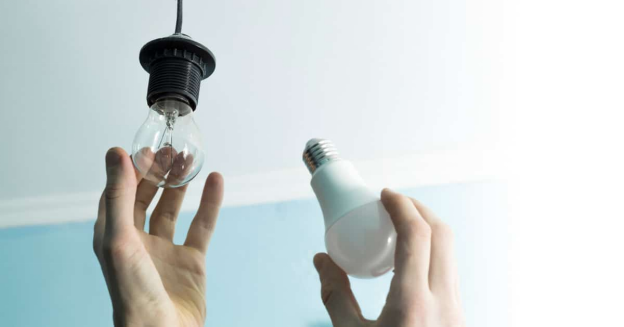
Cost Comparison
A comparison of costs by all means is significant in making the right selection. Below, you will find a detailed breakdown of the different types of costs, followed by the ROI discussion for each bulb type to help you understand it clearly.
LED Cost
The cost of LED light bulbs is higher compared to the traditional bulbs. Hence, you may need a high initial investment but can earn long-term benefits with time. However, various manufacturers of LED light bulbs are now bringing about budget-friendly options equipped with low-cost LED light bulbs to match each customer’s preference.
However, when you consider the cost of ownership of LED bulbs, you can be assured that they will work for tens and thousands of hours compared to other lighting options, and hence, the cost of replacement and maintenance tends to be minimized.
Therefore, although the initial investment is high, the long-term usage and energy efficiency offered by these bulbs help to ensure that the ROI is high throughout the lifespan.
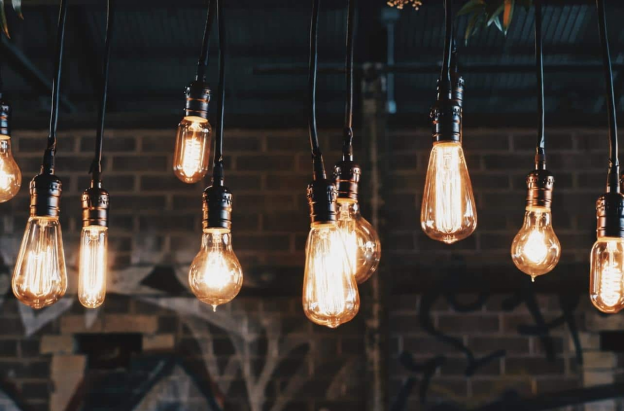
CFL Cost
CFL bulbs are, however, affordable when compared to LED bulbs but when compared to incandescent bulbs. CFL bulbs’ lifespan is shorter than LED bulbs but longer than incandescent bulbs. Moreover, they are more energy efficient than incandescent bulbs.
The cost of ownership of CFL bulbs will also consider the cost of purchase, followed by energy consumption and the cost of replacement. As you may need to replace these bulbs twice a year, the cost of installation will be required to be insured twice.
The ROI of investment on the CFL bulbs is moderate, as it is higher than the incandescent bulbs but lower than the LED bulbs.
Incandescent Bulb Cost
The initial cost of incandescent bulbs is lower than that of the other two types, but the lower efficiency and short life span increase the cost of usage in the long run.
They also consume a lot of electricity; hence, the total cost of ownership for these bulbs is very high because of the consistent replacement and high energy consumption.
The ROI of the incandescent bulbs is also significantly less than that of the other two kinds because of their shorter life span and less energy efficiency.
Life Span Comparison
The lifespan of the three types of light bulbs also varies, and when carrying out the cost assessment, looking at their lifespan is vital. These comparisons are discussed below:
LED Lifespan
LED light bulbs have the longest lifespan. They have an average life ranging between 15000 to 50000 hours, and this span is also accepted by the quality of the LED bulb and the usage pattern. However, LED technology is always known for offering the most cost-effective and durable lighting option.
CFL Lifespan
CFL bulbs have a lifespan that is shorter than that of LED bulbs but longer than that of incandescent bulbs. They can last somewhere between 8000 to 15000 hours. However, the frequent turning on and off can impact the lifespan of CFL bulbs.
Incandescent Bulb Lifespan
On the other hand, incandescent bulbs have the shortest life span, ranging between 750 to 2000 hours, and lack durability; moreover, they can fail anytime because of their design equipped with filament.
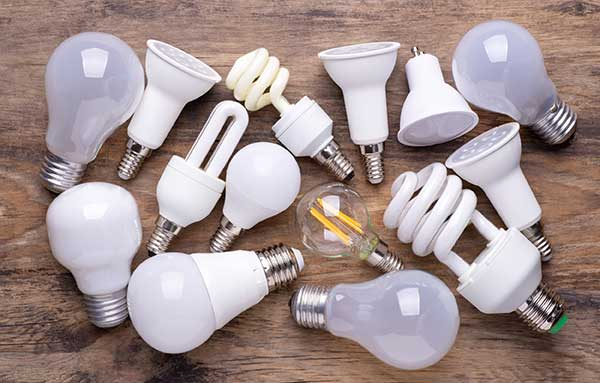
Environmental Impact
Environmental Benefits of Using LED Bulbs
There are multiple benefits of using LED bulbs, and some of these are as follows:
- LED lights are energy efficient; hence, compared to incandescent bulbs, they consume much less electricity, which means less energy demand reduces the electricity generation requirement.
- Due to their energy efficiency, LED lights help reduce carbon emissions in the environment and hence reduce carbon impact on the environment.
- LED bulbs’ lifespan is longer than incandescent bulbs, which means the waste is reduced because of the lesser replacement requirement. Hence, it minimizes the impact on the environment.
How Do LED Bulbs Contribute to Sustainability and Reduce Greenhouse Gas Emissions?
LED bulbs can contribute to sustainability by energy conservation as they even reduce dependency on fossil fuels, reducing environmental degradation.
Moreover, the decrease in the gas emissions by LED bulbs also helps reduce greenhouse gas emissions; hence, climate change is mitigated by moving towards renewable energy resources.
Recycling options and disposal considerations for both types of bulbs
LED bulbs are composed of materials and components capable of being easily recycled; hence, disposing of an LED bulb is easy. However, the local recycling facilities must be checked to ensure they have the means to carry out the disposal.
On the other hand, incandescent bulbs can directly be disposed of along with household waste; however, an eye must be kept on the guidelines of the local regulations to ensure there are any specific requirements to follow.

Practical Tips for Maximizing LED Savings
The tips below will help you maximise possible savings using LED light bulbs.
1. Understanding the Energy-Saving Potential of LED Lighting:
Recognizing that LED bulbs bring significant energy efficiency compared to the traditional incandescent bulb is substantial. It is certain that they consume less power and provide the same brightness level, which helps reduce electricity costs.
2. Choosing the Right LED Bulbs for Different Areas of Your Home:
No one kind of LED bulb goes with the entire area of the home; in fact, every area will require a different brightness level and color temperature. Hence, brighter bulbs are needed in areas like the kitchen and workspaces where tasks are carried out, whereas the living room and bedroom need softer light.
Similarly, the color temperature consideration is also significant; for specific areas, a warmer temperature between 2700 to 3000 K is suitable, whereas, for task-oriented spaces, a cooler temperature between 4000-5000 K proves to be an appropriate option.
3. Maximizing Energy Efficiency with Smart Lighting Controls:
Smart lighting controls always help to equip your LED lighting experience with ease and maximize energy efficiency. You can incorporate dimmer switches, timers, and motion sensors into the LED lighting system. It helps to adjust the light brightness and create a schedule for using these lights. Moreover, it helps to reduce unnecessary electricity consumption.
4. Overcoming Common Misconceptions about LED Lighting:
The myths about LED lighting must be avoided. Many people have myths in mind that the light quality of LED bulbs is not up to the mark or that they flicker a lot. Such myths must be debunked because LED technology has evolved with time, and most issues are already addressed and sorted. However, you should always stick to the best quality LED bulbs.
5. Exploring Government and Industry Resources for LED Lighting:
You must make the most of the advantages and incentives the government offers as there are such scenarios where LED lighting adoption is promoted, and you can enjoy rebates.
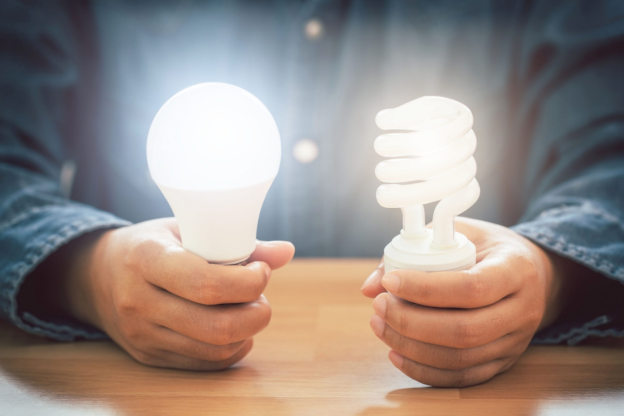
Conclusion: What Are The Actual Savings in LEDs?
The savings in LEDs are equipped with multiple factors. The first is saving on energy costs; in times of high electricity rates, you can save a lot on your utility bills by replacing the entire lighting system at your premises with LEDs.
Moreover, the cost of replacement and maintenance can also be reduced because the LED lights have a longer lifespan, so you need less replacement and maintenance. They also take less time to cool down than incandescent bulbs; hence, your cooling cost during a warm day is even reduced.
The overall cost saving in LEDs is quite exemplary because it proves to be a one-time investment over which you get the return throughout your life in savings. Moreover, opting for government incentives to use LEDs is also an added benefit.
FAQs:
1. Do LED lights or regular lights use more electricity?
Ans. In comparison to LED lights, regular lights consume more electricity.
2. Are LED bulbs more efficient than energy-saving bulbs?
Ans. LED bulbs are more energy efficient than energy-saving bulbs, comprising CFLs.
3. What type of energy reduces consumption by replacing old bulbs with new LEDs?
Ans. The electricity consumption is reduced when the older traditional bulbs are replaced with LEDs.
4. Which bulb consumes less electricity?
Ans. LED bulbs tend to consume lesser amounts of electricity compared to traditional bulbs like incandescent or CFLs.
5. Is it worth switching to LED bulbs?
Ans. Yes, opting for LED bulbs is worth it because they help save electricity costs and reduce replacement costs. Also, the lifespan of LEDs is much longer.
